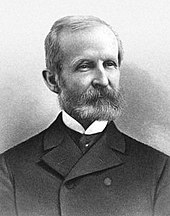John Martyn Harlow
John Martyn Harlow | |
|---|---|
 | |
| Born | November 25, 1819 |
| Died | May 13, 1907 (aged 87) |
| Education | Philadelphia School of Anatomy, Jefferson Medical College |
| Occupation(s) | Physician, bank director |
| Known for | Attendance on brain-injury survivor Phineas Gage |
| Signature | |
John Martyn Harlow (1819–1907) was an American physician primarily remembered for his attendance on brain-injury survivor Phineas Gage, and for his published reports on Gage's accident and subsequent history.

Harlow was born in Whitehall, New York on November 25, 1819 to Ransom and Annis Martyn Harlow.[1] He studied at Philadelphia School of Anatomy and in 1844 graduated from Jefferson Medical College, Philadelphia[2] with an M.D.[3]: 342
His practice in Cavendish, Vermont, where Gage's accident occurred in 1848, brought Gage under his care. In 1857, he left Cavendish due to poor health,[3] and spent three years traveling and studying in Minnesota and Philadelphia before taking up practice in Woburn, Massachusetts[4] in 1861.[3][5]
His first paper on Gage appeared in Boston Medical and Surgical Journal in late 1848; a short progress note appeared early the next year. Almost twenty years later, in 1868, he published a final paper recounting what he had been able to learn about the subsequent history of his patient (who died in 1860), and presenting psychological changes in Gage which, presumably, were sequelae of the accident. In one of the most remarkably strange examples ever of dogged long-term medical follow-up, Harlow, having "trac[ed Gage] in his wanderings over the greater part of this continent"[6]: 3–4 (by which he meant South as well as North America, Gage having spent seven years in Chile before continuing to California) had even obtained Gage's skull for use in preparing the paper.[7]
Harlow was highly active in Woburn civic affairs, serving at various times on the town's water, drainage, and schools committees, and as a library trustee; he was also a state senator and member of the Massachusetts Governor's Council, a trustee of the Massachusetts General Hospital, a bank president and director of another bank, a director of the local gas company, and a local medical official during the Civil War.[1][8]: 195n18
On Harlow's death in 1907, The New York Times called him "one of the oldest and most prominent physicians and surgeons of New England".[9] Childless (although twice married, first to Charlotte Davis and second to Frances Kimball), he left most of his substantial wealth to charity, for example endowing a ward for the poor at Massachusetts General Hospital and a book fund at Woburn Memorial High School's library, which is named for him.[1]
Publications
- Harlow, John Martyn (1848). "Passage of an iron rod through the head". Boston Medical and Surgical Journal. 39 (20): 389–393. doi:10.1056/nejm184812130392001. (also issued as an offprint, vide Cordasco, 60-0808)
- Harlow, John Martyn (1868). "Recovery from the Passage of an Iron Bar through the Head". Publications of the Massachusetts Medical Society. 2 (3): 327–47. Reprinted: David Clapp & Son (1869) [scan]

References
- ^ a b c American Medical Biographies, Howard Atwood Kelly and Walter Lincoln Burrage, Norman, Remington Co., 1920, p. 492
- ^ Samuel Atkins Eliot (1911). Biographical history of Massachusetts: biographies and autobiographies of the leading men in the state, Volume 1. Massachusetts Biographical Society.
- ^ a b c Malcolm Macmillan (2000). An Odd Kind of Fame: Stories of Phineas Gage. MIT Press. p. 351. ISBN 978-0-262-63259-1.
- ^ . Middlesex Journal. November 9, 1861.
- ^ . Minutes of the Middlesex East District Medical Society. December 17, 1861.
- ^ Harlow, John Martyn (1868). "Recovery from the Passage of an Iron Bar through the Head". Publications of the Massachusetts Medical Society. 2 (3): 327–47. Reprinted: David Clapp & Son (1869) [scan]

- ^ John Barnard Swett. "A Descriptive Catalogue of the Warren Anatomical Museum".
- ^ Lena, M. L. (Spring 2018). "The Navvy and the Navigator: Connecting Phineas Gage and Mark Twain's 'Mean Men'". Mark Twain Journal. 56 (1): 166–200.
- ^ The New York Times, May 14, 1907
